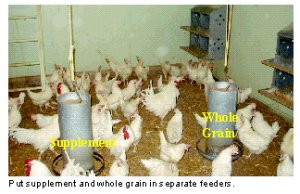Choice-Feeding of Small Laying Hen Flocks
PDF Version (137KB)

Choice-feeding can be an easy way for small flock owners to feed their laying hens. When you choice-feed your hens, you do not have to worry about grinding the grain or mixing it accurately with a supplement. Instead, you have separate feeders for the grain and supplement and let the birds choose how much of each they want to eat. If the feed mill making your supplement recommends that you add extra limestone or oyster shell, you will have a third feeder full of one of these calcium sources.
Laying hens can make good nutritional choices and pick out the amount of grain, supplement and limestone or oyster shell that they need to be healthy and productive. Hens fed this way will lay as many eggs as hens fed a traditional laying hen diet as long as you follow some basic rules:
- Do not give the hens too many choices. Hens can handle up to three choices quite well (grain, supplement and limestone or oystershell). If you want to use more than one grain, such as wheat and barley, you should mix them together in the same feeder.
- Give the hens choices that are nutritionally distinct. For example, grain is high in starch and energy, supplement is high in protein and vitamins and limestone is high in calcium. When provided such clear choices, the hens learn which feeders to go to and how much to eat to meet their basic nutritional needs. Some choices may not be clear enough for the hens. For example, wheat and peas both are high in starch and have moderate levels of protein; having separate feeders of wheat and peas may not provide a distinct enough nutritional difference for the birds.
- Introduce the whole grain and choice-feeding a month before the start of egg production (about 15 weeks of age). This adjustment period will allow the birds time to learn how to choice-feed themselves before they are exposed to the nutritional demands of egg production. It will also allow the pullets the opportunity to increase their calcium consumption and build up the calcium reserves in their bones before they start to lay eggs. Finally, it takes the gizzard three weeks to build muscle mass and you want the hens to be able to efficiently grind the grain once egg production begins.
- Do not feed vitamins or micro-minerals (e.g. copper, zinc etc.) in a separate feeder. Use your supplement as a source of these ingredients. If vitamins or micro-minerals are placed in a separate feeder, some birds may not eat them because they do not like the taste while other birds may over consume them and suffer toxic side effects.
- Give the birds adequate feeder space. If you have a large backyard flock, you may need several feeders for each ingredient. For a one hundred hen barn, two hanging feeders each of grain, supplement and limestone are suggested.
- Purchase a supplement designed to be mixed with grain or grain and limestone to provide a complete laying hen diet. A supplement formulated in this manner will contain in the range of 25% to 40% protein. A grower supplement may be used prior to the start of egg production but use a laying hen supplement once the birds begin egg production.
You do not need to grind the whole grain when you choice-feed your hens. The birds will readily eat whole wheat, whole oats or whole barley (but they can have difficulty eating whole corn). After about three weeks of eating whole grain, the hens' gizzards will increase in muscle mass and will grind the grain as efficiently as a hammer mill. Hens can successfully consume 70% of their diet as whole grain when it is choice-fed. It is important to note that if you want to mix whole grain, supplement and limestone together into a traditional laying hen diet that is fed in one feeder, you should not have more than 50% of the diet as whole grain. The rest of the grain in the feed should be ground. At higher levels of whole grain, the hens sometimes have trouble finding the supplement amongst all of the grain. When the grain, supplement and limestone are in different feeders, these separation problems are avoided.
In summary, choice-feeding can be an easy method of feeding small flocks of laying hens that are kept on the floor. You will avoid the labour of grinding the grain, weighing the feed ingredients and mixing them together. As long as you give them the opportunity to make clear, easy nutritional choices, the hens will be healthy and productive.

